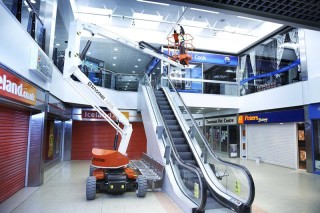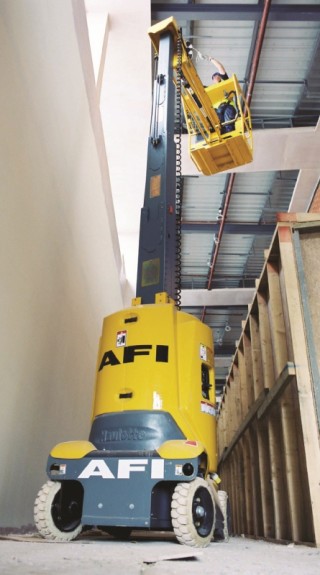Malcolm Bowers, founder-director of hire company Lifterz, sees big opportunities in battery-powered platforms. In the old days, he says, the batteries used to be flat by one or two o’clock. Now they can run all day. In the past, battery power was seen as only for indoor use, where engine emissions of any kind were not an option. This meant it was used for powering scissor lifts that were only designed for operating on smooth factory, shop or office floors – slab use.
Bowers has always aimed at the fit-out and installation contractors rather than the front-end of projects anyway. A powered access industry veteran, he had previously set up Aerials for Industry (now simply AFI), which, as its name suggests, targeted industrial users rather than the construction industry. “I prefer the back end of the construction cycle to the front end,” he says.
Rental rates can be a little higher for battery lifts than for diesel powered ones – and about the same as for LPG. More and more rental companies are now adding battery-powered machines to their inventories, though, and so there is a definite downward pressure on rates. Most of the manufacturers have offered a range of scissor lifts for many years. What is new nowadays is that they are getting bigger, like Holland Lift’s 100ft scissor, and more heavy-duty with greater deck capacity.
There are also now battery powered telescopic boom lifts with oscillating axles and self-levelling baskets for rough terrain applications. In the past, there was seen to be no reason to avoid using diesel on boom lifts as they mostly worked outdoors. If a cleaner alternative was required, LPG has generally been used instead of diesel. However, as Bowers points out, LPG also has fumes and is therefore similarly potentially hazardous. Only battery power is totally emissions-free.
Bowers’ old company, AFI, remains a major operator of battery-powered equipment. AFI has an £8m capital expenditure programme for new powered access equipment for 2012 and 2013 and more than 90% of its 563 new machines are electric. AFI director Nick Selley says that purchasing electric machines is good for both the customer and the hire company: “During recent years we have seen a substantial increase in customer demand for electric machines, particularly in the maintenance and facilities management sectors. Electric machines are lighter than diesel machines so can be used indoors where floor loadings are an issue, and their fume-free operation is another very important feature for indoor use.
“From a hire company’s point of view, electric machines tend to cost less to purchase than diesel models and they retain their value as a percentage of the initial purchase price when we sell them to endusers through our AFI Resale operation.”
AFI’s recent investment in electric machines has included Haulotte Star 10 mast booms, self-propelled Bravi Lites, and pusharound verticals such as the Power Tower and Youngman Boss X3, together with narrow electric scissors such as the Haulotte Compact 14.
At present 62% of AFI’s total fleet of 4,000 machines is electric and that percentage will continue to increase in favour of electric machines as further investment is made, Selley says.
Hire firm Facelift is also investing in battery-power. “There’s no one size fits all solution when it comes to access equipment, so having as many types of equipment available as possible is a key part of our offering,” says operations director Paul Standing. “We’ve invested heavily in new battery scissor lifts over the past 12 months, and can see this continuing.”
As mentioned, electric power is routinely available for scissor lifts. For telescopic and/or articulating boom lifts, however, diesel engines remain dominant. However, there are battery powered options out there and on the whole they tend to be compact models to suit indoor use.

Rental rates can be a little higher for battery lifts than for diesel powered ones – and about the same as for LPG. More and more rental companies are now adding battery-powered machines to their inventories, though, and so there is a definite downward pressure on rates.
Most of the manufacturers have offered a range of scissor lifts for many years. What is new nowadays is that they are getting bigger, like Holland Lift’s 100ft scissor, and more heavy-duty with greater deck capacity. There are also now battery powered telescopic boom lifts with oscillating axles Snorkel has just four electric boom lifts, up to 16.1m reach. Two smaller ones are mast types, while the larger two have articulating booms. All are designed for indoor use, on slab. JLG has a five-model series of battery power and dual mode boom lifts, ranging from the E300, reaching 30ft (11m) working height, up to the 60ft (18m) E600. An optional oscillating axle and all-wheel drive improves ground contact for off-slab performance.
Genie (part of Terex since 2002) also has a couple of battery-powered articulating boom models: Z-34/22 and Z-45/25J, both available in DC or Bi-Energy version, with 12m and 16m working height respectively. Genie describes its bi-energy system as “combining the quiet, emission-free and efficient operation of a 48V DC machine with the versatility of a diesel generator powered machine to provide a boom that is ideal for indoor and outdoor applications.”
Haulotte offers battery-powered articulated booms with 12m and 15m working heights, the HA12IP and HA15IP, as well as four mast booms, branded as Star. The Star machines range from the 6m-working-height Star 6 up to the 10m-working-height Star 10 (pictured below).
While the big overseas manufacturers lead the industry in many regards, Malcolm Bowers credits the UK’s own Niftylift with showing the way on battery power in boom lifts. Niftylift produces only boom lifts and not scissors. It has always offered the option of battery power. Its bi-energy machines are popular with rental companies because they can be hired out to a wider range of endusers.
They can be used by those who work outside and want to use diesel rather than worry about charging batteries. Then at the flick of a switch they can be used indoors, battery-powered and emissions-free. In either case, if one mode runs out of juice, there is always the other mode to switch to. Anything that maximises potential utilisation in this way is likely to be appreciated by rental companies. Then in 2009 Niftylift introduced its first true hybrid machine, which has proved to be something of a step-change for the industry. When hybrid mode is selected, the machine is powered most of the time by diesel. For boom operations or travel on flat level ground, or when idling, the diesel engine is in control. Only when extra power is required, such as when moving uphill or over rough ground, does the battery kick in.
This may seem counter-intuitive. Usually batteries are considered the lighter duty option and diesel for heavy duty. But Niftylift’s approach is essentially a diesel plus-battery hybrid rather than battery-plus-diesel. It means that a much smaller diesel engine can be fitted than would otherwise be required. For example, Niftylift’s old diesel-only HR17 4x4 boom lift was powered by a 32hp (23kW) Kubota 1505 engine. The new hybrid version uses an 18hp (13kW) Kubota 722. The smaller engine, of course, means less fuel consumption, less noise and fewer emissions.
Users of access platforms only rarely need all the engine power that is at their disposal. Niftylift’s hybrid concept exploits this, unlike most other hybrid platforms, which in Nifty’s view are effectively battery-powered machines with a diesel generator attached. On the Nifty hybrids, the batteries are charged automatically by the surplus capacity of the diesel engine when it is just ticking over.
Those working indoors and wanting solely battery power can still select this option on the new parallel hybrids, just as on the bi-energy machines. Batteries can be tricky things to look after and require nurturing for maximum lifespan. Niftylift believes that it has gone a long way to simplifying battery management. Customers seem to agree and the orders are increasingly going to the new generation hybrid machine ahead of the old-style bi-energy option.
Got a story? Email news@theconstructionindex.co.uk




